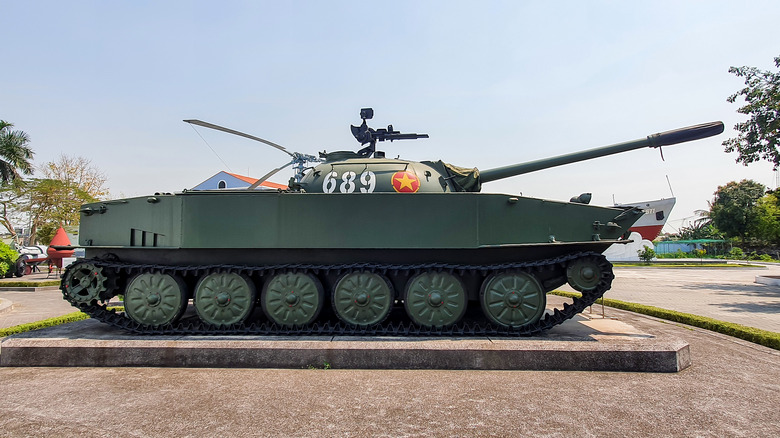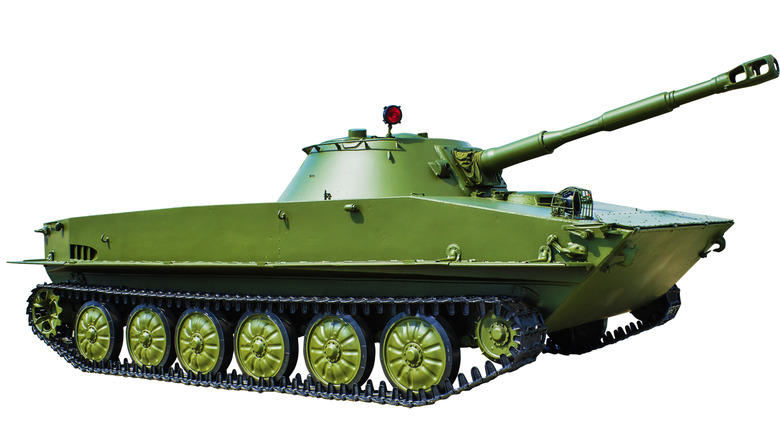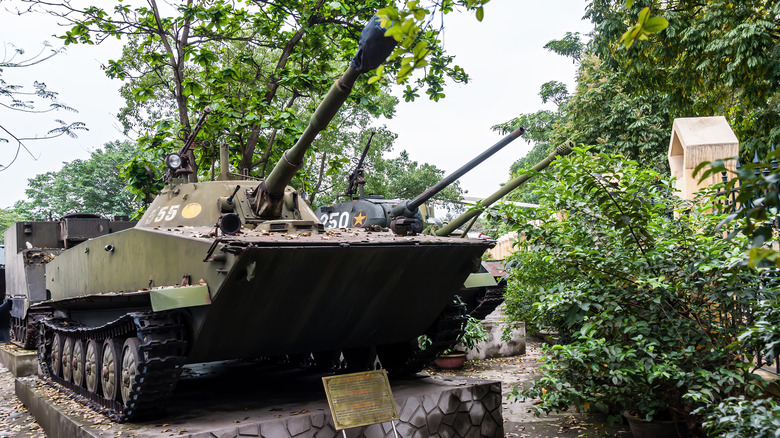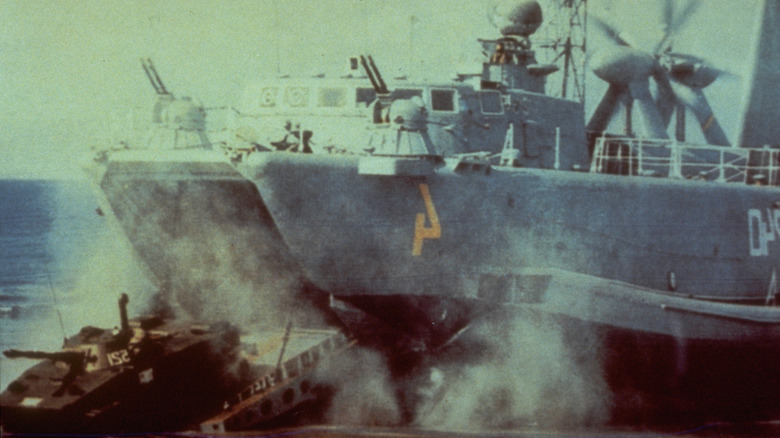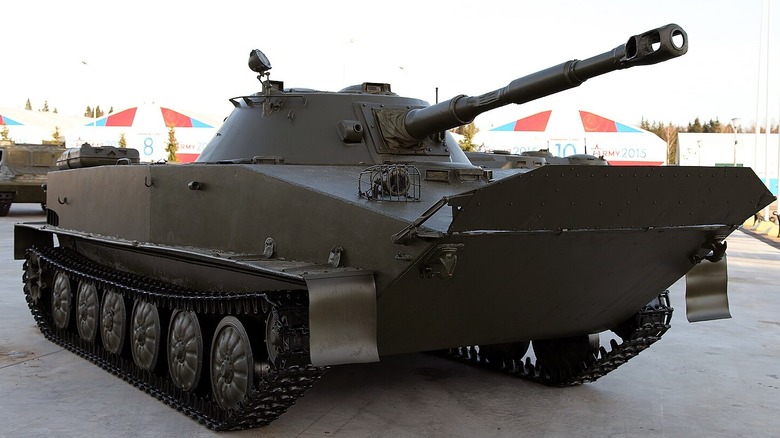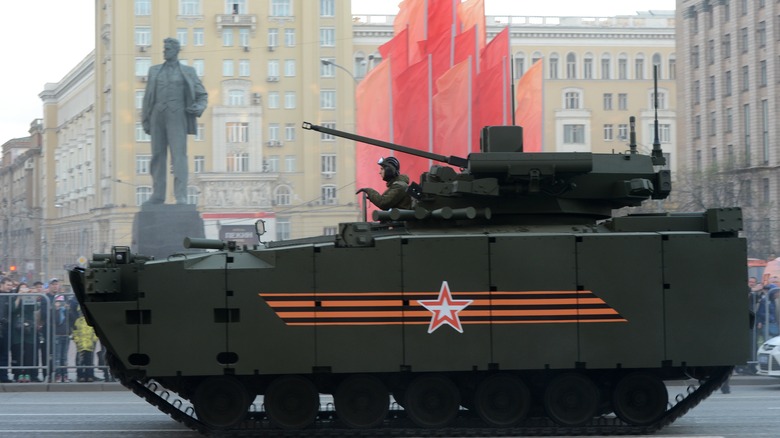All About The Soviet PT-76 Light Amphibious Tank
It wasn't long after coming through victorious in the biggest conflict of all time — World War II — that the Soviet Union and the United States ceased being allies and instead engaged in a decades-long Cold War. The arms race that followed was on a scale the world had never seen, including the stockpiling of nuclear weapons, and led to the development of advanced technology like orbital satellites and the internet. However, it also saw innovations in smaller vehicles and weapons, including tanks.
The PT-76 was the first new tank developed by the Soviet Union after World War II. It predates other Soviet tanks designed during the Cold War, like the T-62 and the T-72 main battle tank. The "76" in its name comes from the size of its main gun, while the "PT" is from the Russian translation for "Swimming Tank." That's because the biggest innovation of this light tank was that it is also amphibious, able to traverse both wet and tough terrain of Central Europe. While it's not one of the largest military tanks, its mobility made the PT-76 a vital component of the Soviet Union's armed forces — and modern-day Russia.
Its unprecedented use of water jets for this purpose isn't the only interesting aspect of the PT-76, which sees combat even today. Here is everything you need to know about the Soviet PT-76 light amphibious tank, including when it was developed and where it has deployed.
The PT-76 was developed if Cold War became hot
The Soviet Union didn't wait long after winning World War II to begin preparing for future wars — this time against the allies it had worked with to defeat the Axis powers. Assuming that wars would be fought in the buffer regions between Western and Eastern Europe, it developed a vehicle to handle the marshes, rivers, and other terrain in Central Europe, which would prove difficult for its heavy and medium tanks.
With this in mind, the Soviets opted for a lighter tank suited for wet terrain that could scout ahead of the more heavily armed and armored units that needed to cross these landscapes. Prototypes for light tanks and amphibious vehicles went into development as early as 1947, with the most successful being one with an innovative water-jet design — Object 740. (Military prototypes made by the Soviets during this era had "object" code names, such as Object 279, a tank too massive to build.)
The prototype of Object 740 was built in February 1950. Later that spring, 10 units were built and tested for several months, with various issues and bugs worked out. By 1952, the tank had been officially approved for military service and was christened the PT-76. It debuted to the public on May 9, 1952 — Victory Day (the Russian holiday celebrating the defeat of Nazi Germany). Eventually, around 12,000 units of the tank were manufactured before production ended in the late 1960s.
The tank could drive in reverse and over water
Light tanks are still tanks, and the PT-76 weighs over 16 tons. It's 25 feet long, 10.3 feet wide, and 7.4 feet tall, giving it just enough room for a three-person crew (a driver, gunner, and commander.) The PT-76 is powered by a six-cylinder, water-cooled V-6B diesel engine that can deliver 240 horsepower at 1,800 rpm. This engine enables the tank to reach a top road speed of 27 mph and gives it a range of 230 miles. Powered by a six-speed drivetrain (five gears plus reverse), the vehicle can climb a 52-degree gradient, cross tall obstacles, stand at 1.1 meters, and traverse 2.8-meter trenches.
Its large size even as a light tank makes it more buoyant. In amphibious mode, twin water jets at the rear propel the PT-76 using two electric bilge pumps, while additional inlet-type water jets over the rear road wheels let the driver steer the tank and run it in reverse. Since it was designed to be agile, less emphasis was put on its armor, which ranged between five and 20 mm thick. Additionally, PT-76 tanks initially lacked any protection from nuclear, biological, or chemical (NBC) weapons.
In addition to the turreted 76.2 mm main gun that gives the tank its name, the vehicle is equipped with a coaxial machine gun that fires 7.62 mm rounds. Many are equipped with an additional 12.7 mm machine gun for air defense too. Typically, the tank can hold 40 rounds for the main gun, 500 rounds for the 12.7 mm gun, and 1,000 rounds of 7.62 ammunition.
The PT-76 has been used in wars across the globe
Fortunately, the Cold War never truly went hot, and the PT-76 wasn't used to invade Western Europe. However, the tank has seen action in several global conflicts, including proxy wars fought by allies of each superpower. The Soviets also exported the PT-76 to other countries. Over two dozen nations have employed the PT-76, including China, Cuba, North Korea, North Vietnam, Laos, Indonesia, Pakistan, India, Iraq, Afghanistan, Poland, Albania, Yugoslavia, and several African states like Egypt and Madagascar. Some of these countries still have surviving PT-76 tanks today, and Russia too.
The Soviets employed the tank during its 1956 invasion of Hungary and 1968 invasion of Czechoslovakia. It was used extensively during the Vietnam War, as well as in wars against Israel, including the Six-Day War and the Yom Kippur War. Other Middle Eastern conflicts where the PT-76 saw action include the Iran-Iraq War and the Gulf Wars. Additionally, the tank was deployed during the Second Chechen War, the Indo-Pakistani Wars of 1965 and 1971, the Laotian Civil War, the Yugoslav Wars of the 1990s, and several wars in Africa, such as the South African Border War and the Angolan Civil War.
The PT-76 continued active service in the Russian army until 2010, when it was finally retired. However, more than 70 years after it first began production, surviving PT-76 tanks were taken out of storage and deployed once again — this time for the Russian invasion of Ukraine. With the Russo-Ukrainian War still ongoing, it's unclear when the PT-76 will be retired for good — again.
Several variants of the PT-76 exist
Like many tanks used for decades, the PT-76 has several variants. A common one is the PT-76B, which is armed with a D-56TS 76.2 mm tank gun and includes an NBC protection system, filtration/ventilation system, and an automatic fire extinguishing system, in addition to improvements to the tank's observational gear, electrical equipment, and engine. Additional fuel tanks were also added to extend the vehicle's range. When a PT-76 or PT-76B turret is fitted with a 12.7 mm anti-aircraft gun on a rotatable mount, the tank is designated as a PT-76A.
The PT-76K is a command variant of the tank modified with an extended-range antenna and an extra electric generator for more power. Some PT-76s had their main guns replaced with slightly larger 85 mm D-58 guns. This version of the tank is subsequently called the PT-85. When the Soviet Union exported the PT-76 to other countries, they were often modified and given localized designations. For example, a modified PT-76M manufactured in Belarus had a different engine, steering, and brakes. When Israeli armed forces captured some PT-76s, they added a new fire control system, a laser range finder, night vision, a 300-horsepower diesel engine, and a larger 90 mm cannon.
[Image by Vitaly V. Kuzmin via Wikimedia Commons | Cropped and scaled | CC BY-SA 3.0]
The IFV has (mostly) replaced the light amphibious tank
Even though some PT-76s are still in service today, the tank was already being replaced by the mid-1960s. Soviet generals decided that light tanks weren't effective enough on the battlefield, and their combat duties were soon transitioned to infantry fighting vehicles (IFVs). While there is no direct successor to the PT-76, IFVs like the BMP-1, which began production in 1965, took the role of the former in many conflicts. The BMP-1 has similar armaments to the PT-76, and — most importantly — it's also amphibious. The BMP-1 is still in service today, including in the Russo-Ukrainian War.
A more recent successor to the PT-76 (and BMP-1) may be the Kurganets-25, an amphibious armored IFV. It's much larger than the PT-76, weighing over 27 tons, with an eight-passenger capacity and a three-man crew. Despite this, it can reach a top speed of over 49 mph, nearly twice that of the PT-76. Truly a 21st-century tank, the Kurganets-25 is controlled by a steering pad heavily based on a PlayStation controller. However, it's been several years since the Kurganets-25 was developed, and Russia still hasn't put the tank into active service. While the days of the aging PT-76 may be numbered, it's still not quite ready to be replaced.
